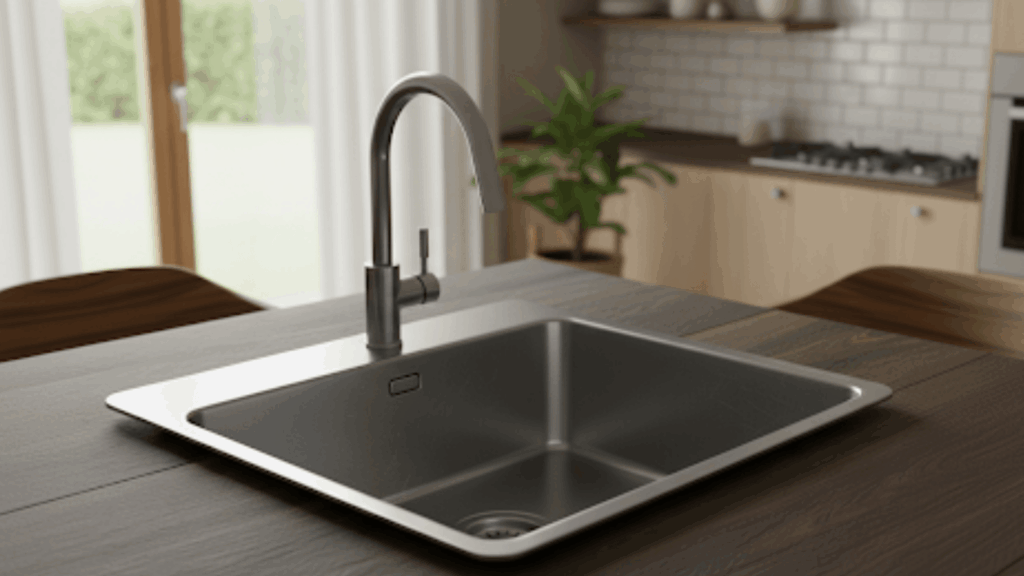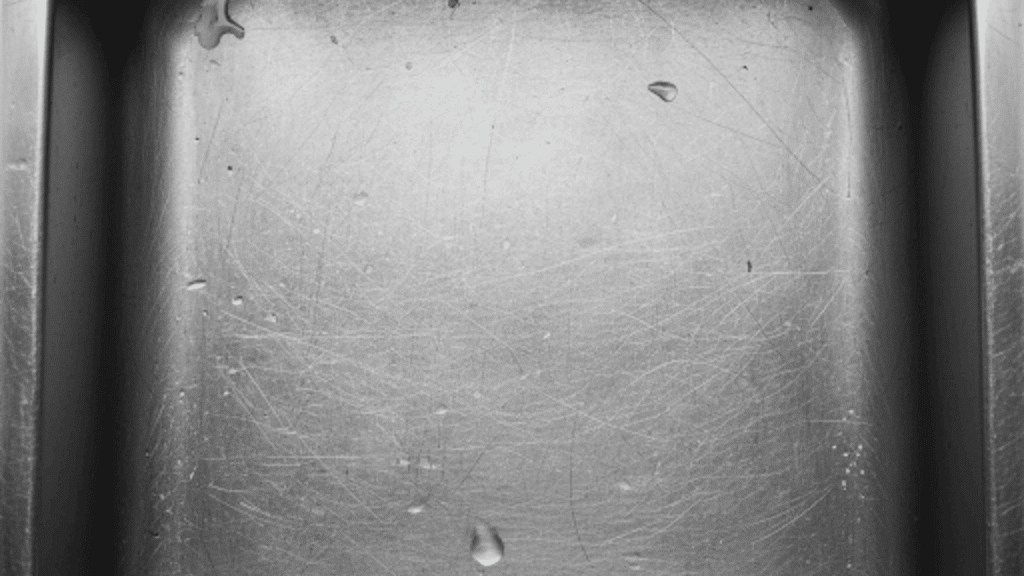Stainless steel is famous for being sleek, modern, and durable, but there’s one thing it’s not resistant to: scratches.
Whether it’s a kitchen sink, fridge door, stovetop, or cookware, even tiny marks can stand out on an otherwise shiny surface.
If you’re wondering how to remove scratches from stainless steel, you’re not alone. The good news is that with the right tools and techniques, most scratches can be minimized or completely buffed out at home.
This guide walks you through removing scratches from stainless steel, including quick DIY methods for light marks and more advanced solutions for deeper damage.
Understanding Scratches: Types & Impact
When it comes to surface damage, knowing the type of scratch helps you choose the right repair method and avoid making things worse.
- Light Scratches: Minor scuffs that show up under light but cannot be felt by touch. They only affect the finish and usually don’t harm the surface itself, though they can make it look dull.
- Deep Scratches: Scratches that go beyond the finish and can be felt or even caught with a fingernail. These often need stronger repair methods or professional help.
Always check the grain direction before attempting to fix scratches. Working against the grain can turn a small problem into bigger damage.
Preparation: Cleaning & Inspection
Start by cleaning the stainless-steel surface with a gentle solution. You can use mild dish soap mixed with warm water, a vinegar solution, or a specialized stainless steel cleaner to remove grease, dirt, and fingerprints.
Ensure that you wipe along the grain of the steel to prevent adding new marks during cleaning.
Once the surface is clean, dry it thoroughly with a soft microfiber cloth to prevent water spots. Under good lighting, carefully inspect the scratch.
A simple fingernail test works well: run your nail lightly over the area. If your nail catches, the scratch is deeper; if it glides smoothly, it’s more superficial.
Easy DIY Methods for Light Scratches

If you’ve just noticed faint marks or small scuffs, start here. These methods are budget-friendly and safe for most stainless steel finishes.
1. Baking Soda Paste
Baking soda is a gentle abrasive that works wonders on light scratches.
- Step 1: Mix 1 tablespoon of baking soda with a few drops of water to form a paste.
- Step 2: Apply it to the scratched area with a microfiber cloth.
- Step 3: Rub firmly in the direction of the grain (never in circles).
- Step 4: Wipe clean with a damp cloth and dry.
2. Toothpaste Trick
Toothpaste isn’t just for teeth; it’s mildly abrasive and can buff away small marks.
- Step 1: Use a non-gel, plain white toothpaste.
- Step 2: Apply a small amount to a soft cloth.
- Step 3: Rub over the scratch in the direction of the grain.
- Step 4: Rinse and wipe clean.
3. Olive Oil or WD-40 Shine
Sometimes scratches don’t need to be removed; they just need to be disguised.
- Step 1: Apply a few drops of olive oil or spray a little WD-40 onto a microfiber cloth.
- Step 2: Buff the scratched area gently.
- Step 3: This won’t “remove” scratches, but can hide them and restore shine.
How to Remove Deep Scratches from Stainless Steel?

Deeper scratches need stronger methods and more patience. Here’s how to tackle them safely.
Use a Stainless Steel Scratch Removal Kit
These kits (available at most hardware stores) come with special sanding pads designed for stainless steel.
- Start with the coarsest pad and rub along the grain.
- Gradually move to finer pads to blend the scratch.
- Finish with stainless steel polish.
Fine-Grit Sandpaper Method
If you don’t have a kit, you can use wet/dry sandpaper.
- Choose 400–600 grit sandpaper for deeper scratches.
- Wrap the paper around a sponge for even pressure.
- Wet the sandpaper and rub in long strokes, following the grain.
- Switch to finer grit (800–1000) for a smooth finish.
- Apply polish afterward.
Finishing Touches: Polishing & Shine
To bring back the shine after cleaning, you can choose from simple household oils to specialized polishes; each option offers unique benefits and precautions for stainless steel.
| Method / Product | Best For | Notes & Precautions |
|---|---|---|
| Olive Oil / Mineral Oil | Every day shine and light protection | Apply a few drops, buff with microfiber; non-abrasive and food-safe. |
| Stainless-Steel Polish | Professional finish and restoring luster | Use as directed; helps hide fingerprints and smudges. |
| Microfiber Buffing | Quick touch-ups without chemicals | Buff in the direction of the grain; safe and simple. |
| Brasso Polish(uncoated stainless only) | Removing tarnish and deeper marks | Abrasive, always test in a hidden spot first. |
| Signature Polish / Penny Brite | Fine scratches and stubborn spots | Follow manufacturer instructions carefully for best results. |
Community Tips & Voices
When it comes to removing scratches from stainless steel, community members agree that patience and the right approach matter most.
On StackExchange DIY, one user recommends starting with a Scotch-Brite pad to create uniform scratches, then progressing to finer grit until smooth, and finishing with stainless steel cleaner and polish for a sleek look.
Over on Reddit’s r/fixit, another tip suggests using a fine metal polishing compound, or even toothpaste, with a cloth or old pot scourer.
Both emphasize taking your time, working with the grain of the steel, and avoiding harsh shortcuts that could worsen the damage.
Preventing Future Scratches on Stainless Steel
Once you’ve fixed the problem, keep your stainless steel looking brand new with these tips:
- Use Cutting Boards: Never chop directly on stainless steel surfaces.
- Avoid Dragging Heavy Items: Lift pans or appliances instead of sliding them.
- Choose the Right Cleaners: Stick to microfiber cloths and avoid abrasive sponges.
- Polish Regularly: Applying a thin coat of stainless steel polish creates a protective barrier against scratches.
Final Thoughts
Scratches on stainless steel can be frustrating, but they don’t have to be permanent.
Light scratches are easily handled with simple household items like baking soda or toothpaste, while deeper ones may require sanding kits or professional refinishing.
The key is patience, the right tools, and always working with the grain of the steel.
With these methods, removing scratches from stainless steel is completely doable, and you’ll keep your appliances, cookware, and fixtures looking shiny and new for years to come.
Frequently Asked Questions
Will Vinegar or Lemon Juice Remove Scratches?
No, while they’re excellent natural cleaners, they don’t have the abrasive quality needed for scratch removal. Stick with baking soda or toothpaste instead.
What’s the Difference Between Brushed and Polished Stainless Steel?
Brushed finishes hide scratches more easily and are safer to sand. Polished or mirror finishes are more challenging and may require professional assistance.
How Much Does Professional Stainless Steel Scratch Removal Cost?
Prices vary, but expect to pay anywhere from $100–$300 for appliance refinishing, depending on size and severity.














